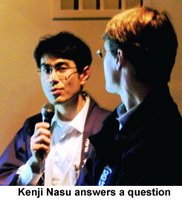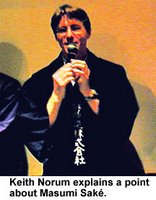May 1, 2006
My favorite izakaya, Sakagura, hosted a saké extravaganza featuring 30 different sakés covering basically all types except koshu. As you can imagine, this was a saké lovers' dream!
Here are the list of sakes by category and in alphabetical order:
Daiginjo class: Daishichi "Minowamon" Kimoto Junmai Ginjo, Hakuryu Daiginjo, Ken Daiginjo, Kokuryu Daiginjo, Kubota "Hekijyu" Yamahai Junmai Daiginjo, Momokawa Daiginjo, Nanbu Bijin Daiginjo, Tsukasabotan Junmai Daiginjo Shizuku, Yuki No Bosha "Akita Komachi" Daiginjo.
Ginjo class: Daishichi "Kaiden" Kimoto Junmai Ginjo, Dewzakura "Oka Yamadanishiki" Junmai Ginjo, Kimi No I "Kurahiden" Yamahai Junmai Ginjo, Kirakucho Junmai Ginjo, Kokuryu Junmai Ginjo, Kudoki Jozu Junmai Ginjo, Masumi Yamahai Junmai Ginjo, Sudo Honke "Yusura" Junmai Ginjo NamazakéTsuki No Katsura "Yanagi" Junmai Ginjo, Yuki No Bosha Junmai Ginjo.
Others: Ama No To Junmai, Dassai Junmai Ginjo Nigori, Hoyo "Genji" Tokubetsu Junmai, Karen Junmai, Kasumitsuru Honjozo, Otokoyama Fukkoshu, Ryusei Tokubetsu Junmai, Taiheizan Kimoto Junmai, Yatagarasu Taruzaké, Yukikage Tokubetsu Junmai.
 Here are the highlights:
Here are the highlights:Gold Medal: The top of the show goes to Daishichi Brewery's Kimoto Junmai Daiginjo, "Minowamon" (SMV: N/A, Acidity: N/A, Rice: Yamadanishiki, Seimaibuai: "Irrelevant," Yeast: N/A), where you can read the notes here (actually, scroll down 1/3 page...). As you notice, this is Minowamon's second Gold Medal finish in two month! One interesting note: few days after the JFC tasting, I met Mr. Hideharu Ota, President of the brewery. I asked about the polishing ratio, and his response was "irrelevant" due to their unique polishing ratio. It is said that 50% seimaibuai using Super-flat Polishing Method would contain more pure starch than 35% seimaibuai using traditional method.
 Silver Medal: Yuki No Bosha Akita Komachi Daiginjo (SMV: +2, Acidity: 1.5, Rice: Akita Komachi, Seimaibuai: 35%, Yeast: N/A) by Saiya Brewery. Using the local rice Akita Komachi, this bottle featured mildly fruity nose before revealing rich pineapple, "amami," and lychee on the palate. The finish is very long and balanced, and leaves you begging for more.
Silver Medal: Yuki No Bosha Akita Komachi Daiginjo (SMV: +2, Acidity: 1.5, Rice: Akita Komachi, Seimaibuai: 35%, Yeast: N/A) by Saiya Brewery. Using the local rice Akita Komachi, this bottle featured mildly fruity nose before revealing rich pineapple, "amami," and lychee on the palate. The finish is very long and balanced, and leaves you begging for more.Bronze Medal: The awards mounted to a Daiginjo-class hat trick, as Kokuryu Daiginjo from Fukui Prefecture captured the Bronze. This was a revealing Daiginjo, as it was not as fruity as others that were being tasted. While it did feature mild fruit on the nose, the flavor was focused with flavors of steamed rice and presence of umami. While initially subtle by comparison, this is a saké that gets better more you drink, and just grows on you.
 Eye-opener of the night: While it was far from the best saké of the night, we were introduced to a style called Fukkoshu Junmai Genshu (SMV: -50, Acidity: 3.5, Rice: Toyonishiki, Seimaibuai: 70%, Yeast: Assoc. #701), meaning "revival saké." This is a speciality by Otokoyama Brewery from Hokkaido, made in a very traditional method mimicking the style of saké from about 300 years ago. While the nose features a aromas of steamed rice, the surprise was in the whiskey-like graininess and a sweet and long finish temepered by high acidity. They say that you learn something new every day... well, this certainly qualifies as my lesson of the day!
Eye-opener of the night: While it was far from the best saké of the night, we were introduced to a style called Fukkoshu Junmai Genshu (SMV: -50, Acidity: 3.5, Rice: Toyonishiki, Seimaibuai: 70%, Yeast: Assoc. #701), meaning "revival saké." This is a speciality by Otokoyama Brewery from Hokkaido, made in a very traditional method mimicking the style of saké from about 300 years ago. While the nose features a aromas of steamed rice, the surprise was in the whiskey-like graininess and a sweet and long finish temepered by high acidity. They say that you learn something new every day... well, this certainly qualifies as my lesson of the day!************************************************************
May 15, 2006
Mere 10 days later, Sakagura was a host to a brewery tasting featuring fantastic selections by one of my favorite kuras, Miyasaka Shuzo and their Masumi brand of sakés. I attended this event with my Saké Buddies Tim Sullivan and Lefty.
First, some information about the kura: Established in 1662 high in the mountains of Nagano, Miyasaka Shuzo makes popular Masumi as well as their limited Miyasaka labels. They are one of the revolutionary kura, having discovered the industry standard "Association #7" yeast that is currently used by about 60% of the brewery nation-wide. After the popularity of their saké skyrocketed thanks to this yeast, the brewery built a second location to accomodate the increase in demand. With features reflecting the elements of clean water and long cold winter ideal for fermentation, Masumi is truly one of the finest terroir driven saké in Japan.
 For this event, two representatives of the brewery were present: Toji (Brewmaster) Mr. Kenji Nasu, and Overseas Operations officer Mr. Keith Norum. In speaking with Keith, I discovered that he became part of this operation after meeting a representative of the brewery at a BBQ. (How come nothing like that ever happens to me?!)
For this event, two representatives of the brewery were present: Toji (Brewmaster) Mr. Kenji Nasu, and Overseas Operations officer Mr. Keith Norum. In speaking with Keith, I discovered that he became part of this operation after meeting a representative of the brewery at a BBQ. (How come nothing like that ever happens to me?!)The tasting began with their namazaké "Arabshiri," where you can find my notes towards the bottom of the page over here.
The next selection was Okuden Kanzukuri Junmai (SMV: +3, Acidity: 1.5, Rice: 80% Miyamanishiki/ 20% Hitogokochi, Seimaibuai: 60%, Yeast: Assoc. #7). This is one of my favorite "everyday" bottle, and one of the best value performer. As the data indicate, this can technically be called a Junmai Ginjo, but it can be found for about $23, a price that may be on the lower end even for Junmai! What I especially like about this saké is the muted complexity. There are a lot of flavor components including notes of rice, mild fruitiness, and subtle earth and grains, yet just like a fine aged wine, those elements are gracefully integrated. This is hardly a surprise, as "Kanzukuri" means "cold brewed," and this mild flavor profile is a clear testament to the slow fermentation that is the hallmark of cold Nagano winter.
 At this stage, Nasu-san, with Keith translating, ran a slide show demonstration to introduce the audience to their kura and production method. They were graceful to answer some of the more technical questions, which covered topics such as pressing method and fermentation and storage temperature.
At this stage, Nasu-san, with Keith translating, ran a slide show demonstration to introduce the audience to their kura and production method. They were graceful to answer some of the more technical questions, which covered topics such as pressing method and fermentation and storage temperature. Naturally, the next offering provided a sharp contrast to the gracefulness of Okuden Kanzukuri. Yamahai Junmai Ginjo (SMV: +2, Acidity: 1.9, Rice: 80% Miyamanishiki/ 20% Hitogokochi, Seimaibuai: 55%, Yeast: Assoc. #7) is, as the name suggests, made using the traditional slow fermentation process called Yamahai. Yamahai, like Kimoto, produces a saké that is richer and more expressive. The nose was very creamy, and the flavor was very upfront with notes of steamed rice and dried fruits before leading to a clean finish.
Naturally, the next offering provided a sharp contrast to the gracefulness of Okuden Kanzukuri. Yamahai Junmai Ginjo (SMV: +2, Acidity: 1.9, Rice: 80% Miyamanishiki/ 20% Hitogokochi, Seimaibuai: 55%, Yeast: Assoc. #7) is, as the name suggests, made using the traditional slow fermentation process called Yamahai. Yamahai, like Kimoto, produces a saké that is richer and more expressive. The nose was very creamy, and the flavor was very upfront with notes of steamed rice and dried fruits before leading to a clean finish. After that came Nanago Yamahai Junmai Daiginjo(SMV: -1, Acidity: 2.0, Rice: Miyamanishiki, Seimaibuai: 49%, Yeast: Assoc. #7), a natural progression from Ginjo to Daiginjo grade. Named after the famed yeast and made with 100% Miyamanishiki, the rice of Nagano, Nanago was very different from the Yamahai Junmai Ginjo. The nose was fruity with refreshing frothiness as one would get from green apples. The approach was decidedly softer, followed by flavors of crisp nashi (Japanese pear). The finish was very refreshing and lasting. I'd drink this all day long, except my budget won't let me!
After that came Nanago Yamahai Junmai Daiginjo(SMV: -1, Acidity: 2.0, Rice: Miyamanishiki, Seimaibuai: 49%, Yeast: Assoc. #7), a natural progression from Ginjo to Daiginjo grade. Named after the famed yeast and made with 100% Miyamanishiki, the rice of Nagano, Nanago was very different from the Yamahai Junmai Ginjo. The nose was fruity with refreshing frothiness as one would get from green apples. The approach was decidedly softer, followed by flavors of crisp nashi (Japanese pear). The finish was very refreshing and lasting. I'd drink this all day long, except my budget won't let me! The last was the pride of the kura, Yumedono Daiginjo (SMV: +5, Acidity: 1.3, Rice: Yamadanishiki, Seimaibuai: 40%, Yeast: Assoc. #9). Made for the puropose of entering national tasting competitions, Yumedono is a limited, hand- produced label featuring the King of Rice polished down to 40%. Nasu-san explained that they use Association #9 yeast to separate itself from the competition, as ironically, there are many competing Daiginjos made using the very #7 that Masumi developed! Lastly, they add mintue amount of brewer's alcohol to preserve flavor. The result is a saké that is very fruity starting from the nose. The ripe tropical fruit notes flow right from the aroma to the palate, with a soft and velvety apporach in between. The finish is lasting and pleasantly dry. This saké defintitely hit the spot, and Keith and Nasu-san were kind enough to let me "review" this saké a few times!
The last was the pride of the kura, Yumedono Daiginjo (SMV: +5, Acidity: 1.3, Rice: Yamadanishiki, Seimaibuai: 40%, Yeast: Assoc. #9). Made for the puropose of entering national tasting competitions, Yumedono is a limited, hand- produced label featuring the King of Rice polished down to 40%. Nasu-san explained that they use Association #9 yeast to separate itself from the competition, as ironically, there are many competing Daiginjos made using the very #7 that Masumi developed! Lastly, they add mintue amount of brewer's alcohol to preserve flavor. The result is a saké that is very fruity starting from the nose. The ripe tropical fruit notes flow right from the aroma to the palate, with a soft and velvety apporach in between. The finish is lasting and pleasantly dry. This saké defintitely hit the spot, and Keith and Nasu-san were kind enough to let me "review" this saké a few times!Although the sakés were great, what really stood out were the passion of Keith and Nasu-san. The amount of respect and appreciation increases exponentially when the Brewmaster is there to explain all care and the details that go into making each saké, and then to have him pour part of his heart and soul into a glass for you to enjoy...

No comments:
Post a Comment